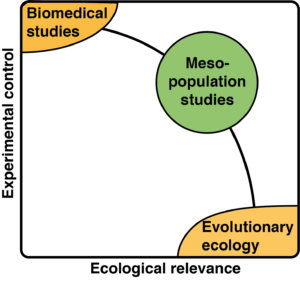A Meso-population study!
We use zebra finches to study a range of issues on the interface of evolutionary, physiological and behavioural ecology. More specifically, we are interested in ageing and how it is shaped by environmental conditions, in particular during development. We do this in the context of meso-populations, that we designed to bridge the gap between the biomedical research field and evolutionary ecology. As applied here, ‘meso‘ (=‘intermediate’) indicates that the groups of individually tracked animals are intermediate between the (mostly) solitary animals in biomedical studies and natural populations, both with respect to their numbers and with respect to their environment. Because we are interested in ageing, and zebra-finches have a lifespan of 3-4 years on average, we maintain the meso-populations for years, and the aviaries are periodically restocked to maintain approximately constant bird numbers throughout the study. All meso-populations are housed in outdoor aviaries, exposing them to natural fluctuations in light and climate..

In our ongoing project, we combine three experimental manipulations, that each represent ecologically relevant challenges: (1) Foraging conditions in each aviary are either easy or “hard” (details), (2) Aviaries differ in whether birds have the opportunity to reproduce or not. Breeding opportunity is varied by either offering nest boxes and nest material or not. (3) All birds that are entered in the experiment were reared in either a small brood (2 young) or a large brood (6 young); these manipulated brood sizes were created by cross-fostering nestlings within a few days of hatching. Each treatment combination is replicated (2 foraging costs levels x 2 breeding levels = 4 treatment combinations, each replicated, housed in eight aviaries. The figure below is a graphic presentation of the experimental design.

We have previously shown that the increase in foraging costs shortens lifespan, but only in birds reared in large broods (Briga et al 2017), and expanded the design in the current experiment by also including a comparison between breeding and non-breeding birds. We predict that lifespan will be shorter in meso-populations with the opportunity to reproduce, in particular when foraging costs are high. Our overarching aim here is to develop an ecologically relevant ageing model, for the longitudinal study of ageing mechanisms.